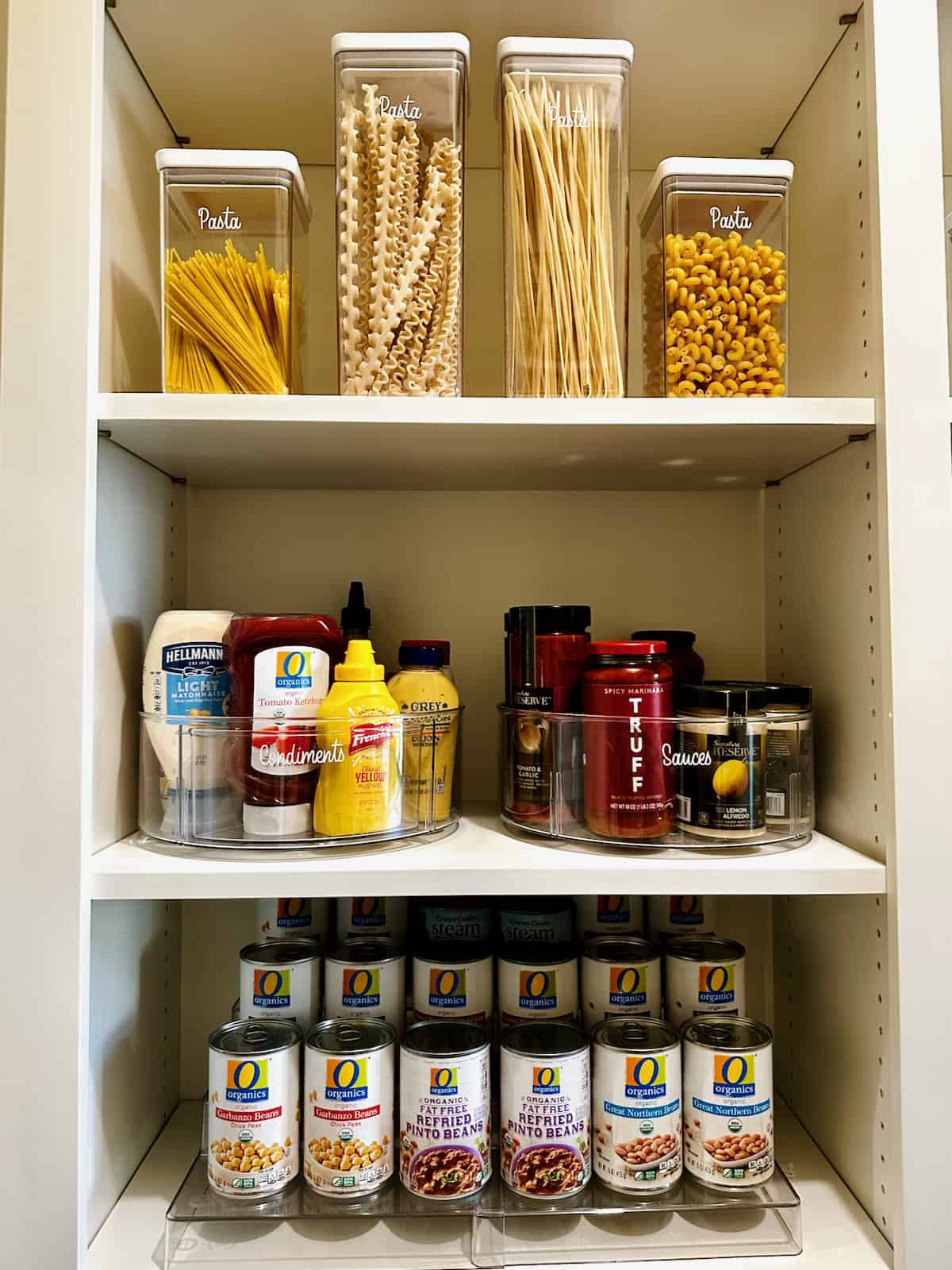From how often to how much, and the best ways to get organized, I share all my step-by-step pantry restocking tips so you can have an organized pantry that serves your family’s needs.

An Organized Pantry Makes Life Easier
A functional, organized and beautiful pantry makes me so happy! It also makes me likely to use and get creative with the ingredients that we have on hand. No matter the size of your pantry, keeping it organized and well-stocked is a great way to set you up for success when it comes to feeding your family on a daily basis.
A well-organized pantry will help you have everything you need when you need it. It saves money, too. Organization can prevent you from overbuying ingredients that you already have on hand because they’re hidden in messy shelves.

I appreciate being able to have the pantry space to store so much and see everything and stock it so well for my family and my business. I realize that having a pantry of this size and stocked so well is a privilege that I don’t take lightly. I’m incredibly thankful each time I walk in it and use it.
I’m so excited to share my step-by-step pantry restocking process and easy tips so you can have an organized pantry that serves your family’s needs.
Plan Ahead
Establishing a schedule for restocking my pantry was a MUST. I’m a busy mom and business owner and if it’s not on the calendar it doesn’t get done. Restocking your pantry regularly helps ensure you always have ingredients on hand for meals and snacks. By staying organized and keeping track of the ingredients in your pantry, you’ll always be well-stocked and ready for any recipe.
Weekly, I do a small restock. This includes items that we enjoy the most often like bread, tortillas, refried beans, protein bars, and granola.
Monthly, I do a medium restock. This includes commonly used pantry staples like canned beans, salsas, pasta, pasta sauce, packaged snacks, cereals and chips.
Every quarter, I do a big restock, which includes deep cleaning the shelves and all containers as well as refilling/replacing all baking supplies, grains like rice and beans, board building supplies and seasonal items like:
- Fall – all things baking, pumpkin and pumpkin pie spice.
- Winter – more holiday baking, hearty soup making, peppermint and hot chocolate makings.
- Spring – quinoa, couscous, dried fruits, nuts, light sauces, tomatoes and anything that will go into a salad.
- Summer – fun snacks, pastas, tortillas, condiments for cookouts, and s’mores makings.
This big restock really takes into account our eating and meal patterns during that season of the year/life. It’s surprising how much our pantry staples and overall stock changes each quarter based on the season of the year, our work schedules, the kids’ schedules, the projects I’m working on for The BakerMama and the growth spurts that the kids might be going through.

Watch Me Restock My Pantry!
Welcome to our pantry! Watch me do a big restock before the holiday season.
Pantry Organization Steps
Declutter and Discard
First, declutter. I go one section at a time so it’s not overwhelming and I can focus on the ingredients in that section. Discard anything that’s expired or that tastes stale. I usually try to do this when I’m hungry for a snack because I’ll snack my way through the pantry.
Donate any unopened, non-perishable foods that are still good but that you won’t realistically use to a local food bank or take them to the teachers’ lounge at your kid’s school.

Clean and Reorganize
Next, clean everything up. Wipe down the cabinets. Wash and dry any empty containers so they’ll be clean and ready to be filled with fresh ingredients. Group similar items together. Bring items to the front that will expire soon so they’re used first.

Take Inventory and Make a List
Then get an idea of what you have and what you need. On a weekly basis, I quickly check the pantry for items we’re low on and add them to my shopping list. I use clear and labeled bins so I can see everything and know when something is running low.
I plan our meals around what we have on hand or what we need to use up before it expires. I keep a dedicated notes section on my phone for groceries so if I’ve noticed that we need something before I take inventory, I will add it to that list. It also helps to keep a running list of your pantry staples that you update regularly and check for each time you grocery shop.

I go into my pantry when making my grocery list so everything is in front of me for easy checking and determining how much we need of each item. I use the term “shop my pantry” a lot before I actually go “shop the store”. When I’m planning out our family meals and developing recipes for the blog, I create my list of everything I’ll need and then I go “shop my pantry” and check off everything that I have in the pantry first and then I’ll go to the store or order everything else I need online.
It also helps to have “sections” to your pantry similar to how you shop them at the grocery store. That way when you open or walk into your pantry, you know which section to go to for the ingredient you’re looking for. For example, I have a canned goods section for all the different tomatoes and a canned goods section for all the different beans and I don’t mix those canned goods so I know exactly where to check for certain tomatoes or certain beans. Having these sections also makes it so easy to check for ingredients when creating my weekly or quarterly shopping lists and makes restocking the pantry a breeze when I get home from the store and start putting everything in its designated section.

Shop
I find that placing my grocery order online for pick-up or delivery insures that I don’t forget anything and that I don’t overbuy once at the store as I’m easily tempted to buy more than we need or have room for when browsing the aisles.
I love that my grocery store app has custom lists built into it for each section of my pantry and fridge so I can easily go to each section and add the ingredients we need to my cart. It also tracks all of my previous purchases from that store and has them in the order of how frequent I buy each item so I’ll quickly double check my past purchases to see if there’s something I missed when taking inventory.

Restock
Finally, once I have all of my groceries ready to restock, I organize them by section throughout the kitchen or on the dining table and then I work by section to put everything where it needs to go in the pantry.
If there are some items in a container that are still good, I’ll pour those items into a bowl, add the new ingredients and then top the container off with the ingredients that need to be used first. I do this a lot with our chocolate chips, peanut butter filled pretzels, granola and other items I know we use regularly.
Label and Date
When fully restocking containers with items that tend to stay in our pantry for longer periods of time as we use them like rice, some pastas, some baking items, some nuts, etc., I label the back of the container with these removable labels and write the expiration date so we don’t have to guess whether something is still fresh.

Extras and Emergency Goods
I like to keep large storage baskets with “extras” at the top or bottom of our pantry with longer shelf life items that I buy in bulk and use to replenish items in containers as they get used. I also put larger items in these baskets that won’t fit on the shelves or items that we don’t use as often.
I also make sure we always have a good stock of emergency items like canned soups, canned vegetables, peanut butter, oatmeal packets and granola bars.

A functional and well-stocked pantry makes any home cook’s job that much simpler. I hope these tips help you organize and re-stock your pantry so that it’s as easy to look at as it is easy to use. Follow along on Instagram for more. If you’re on Facebook, be sure to join my Friends of The BakerMama group to connect and share all the fun and yummy recipes of mine that you make! 
xoxo,














